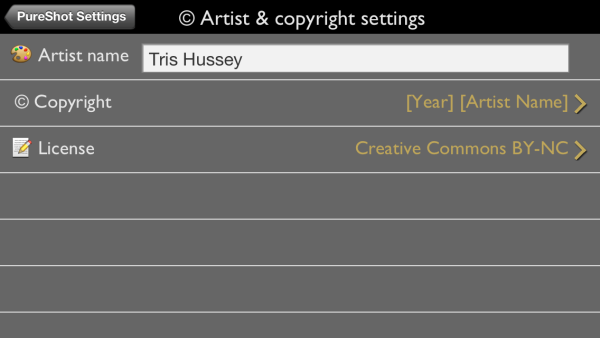Although I have two point-n-shoots and a DSLR handy for taking pictures, it’s my iPhone 5 that generally gets the most use. Why? Because I have it with me almost all the time too. Not to mention I can shoot, edit (sometimes), and share a photo from my iPhone much, much faster than I ever could with my other cameras (import into a device, check, post, etc). Still, I prefer to shoot in RAW or have my pictures compresses as little as possible when I have the option. Less compression equals more flexibility editing. If there is more of the original photo left for me to work with I can push the boundaries of the image much better. Alas, that function isn’t in most iPhone apps. Until now. PureShot lets you save an uncompressed dRAW (aka TIFF) image. Results? Well, not what you might expect.
PureShot runs $2 in the App Store and for pro-level photo apps, yeah it’s right up there with the best I’ve used. You don’t just get control over a lot of the settings (though not crazy over-control as I’ve seen in some apps), but three image quality settings: dRAW, MaxJPEG, and HQJPEG. The idea being to allow you to capture an image in all its glory if you so choose. One additional setting I especially appreciate, is the ability to set copyright information (my name, date, and Creative Commons license) into the meta data of the photo automatically. All this is great, but the proof is in the pudding (pictures), isn’t it? If you’re going to pay $2 for an app, and ones that is supposed to sport a special feature, it should be worth it. So I did some test shots.
I set up my iPhone 5 on a tripod (the Joby one, btw) and used a cable release (aka headphone cable—btw you have to turn the “hardware shutter” on in PureShot for that to work) to take pictures with both the default camera app and PureShot (dRAW, MaxJPEG, and HQJPEG versions). I also, just for comparison, brought out my Samsung point-n-shoot (16 mega pixel) just to see what difference that might make (I don’t have cable release, so that shot was with a 10 second timer). All shots were taken at the same place and time. I left all other settings, even where to focus, on auto. I took them directly from my iPhone and point-n-shoot using Dropbox’s camera import which doesn’t compress the photos in transport.
I imported all of them into Aperture and (at first) made no adjustments. I exported the phots with the same export profile (JPEG, highest quality, scaled long side to 600 pixels). To test the dRAW with more info is better for editing theory, I edited the dRAW and default app versions the same way in Aperture (which is hitting “auto fix”) and exported those with the same export profile as above.
Before I get to the images, let me talk file size, because when you want to have a guesstimate of an image’s quality; how big the file is can be a solid place to start.
- Default camera app: 3.1 MB
- PureShot dRAW: 24 MB
- PureShot MaxJPEG: 7.3 MB
- PureShot HQJPEG: 2.5 MB (which surprised me actually, I thought it would be better than the default app)
- Point-n-shoot: 6.8 MB (16 mega pixel, highest quality setting)
So on pure file size terms the dRAW version lives up to its billing—it’s uncompressed alright (in comparison the RAW files from my Nikon D30 are about 10-11 MB). The MaxJPEG is on par with a point-n-shoot in terms of size, but quality? That judgment comes in a moment.
Let’s get to actual results:
Yes, you have to look very, very carefully to see differences, except for the point-n-shoot. I think all the iPhone shots (regardless of app) are a bit under exposed. Remember, all of them have been exported with the same JPEG setting and same size. It’s worth noting that all the iPhone images start at 2448 x 3264 pixels and the Samsung at 3456 x 4608.
Now for edited images:
Differences? Scant. That is actually to be expected because I didn’t really push the images too much (like contrast or exposure). Now when I start pushing things a little, that’s when you can start seeing why starting with uncompressed files pays off:
Yes, very subtle, but there. If these were images I really had to push, I think the differences would start to stand out.
So, is this a photo app for everyone (it is only $2), no not really. For guys like me who do like to take a lot of pictures, this might be an app I pull out when the lighting is tough or I’m doing product shots (and my DSLR isn’t handy). Most folks, I think this is overkill. I’m happy I spent the money, and know I’ll enjoy using the app, but it won’t be my everyday app (unless I could use it from the lock screen, and even then maybe not). Solid app though. Solid app for semi-pro and pro photographers though.
HT: Cult of Mac.

